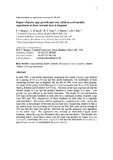JavaScript is disabled for your browser. Some features of this site may not work without it.
| dc.contributor.author | Burgess, Paul J. | - |
| dc.contributor.author | Incoll, L. D. | - |
| dc.contributor.author | Corry, D. T. | - |
| dc.contributor.author | Beaton, A. | - |
| dc.contributor.author | Hart, B. J. | - |
| dc.date.accessioned | 2011-04-14T23:45:30Z | |
| dc.date.available | 2011-04-14T23:45:30Z | |
| dc.date.issued | 2004-01-01T00:00:00Z | - |
| dc.identifier.citation | P. J. Burgess, L. D. Incoll, D. T. Corry, A. Beaton, & B. J. Hart, Poplar (Populus spp) growth and crop yields in a silvoarable experiment at three lowland sites in England, Agroforestry Systems, 63, 157-169 | en_UK |
| dc.identifier.issn | 0167-4366 | - |
| dc.identifier.uri | http://dx.doi.org/10.1007/s10457-004-7169-9 | - |
| dc.identifier.uri | http://dspace.lib.cranfield.ac.uk/handle/1826/872 | |
| dc.description.abstract | In early 1992, a silvoarable experiment, comprising four poplar (Populus spp.) hybrids (at a spacing of 10 m x 6.4 m) and four arable treatments, was established at three contrasting lowland sites in England. By the end of 1998, seven years after planting, the height of the poplar hybrid Beaupré (11.9 m) was greater than those of the hybrids Gibecq, Robusta and Trichobel (8.9-9.8 m). The trees at the most exposed site had the shortest height (9.2 m) and the greatest diameter at breast height (173 mm). Tree growth was also affected by the arable treatments. The height (9.5 m) and diameter (143 mm) of the trees bordered on both sides by a continuous rotation of arable crops were 89% and 79%, respectively, of those bordered on both sides by a regularly cultivated fallow. This result could be explained by competition for water. Across the three sites, in the presence of the trees the yield per unit cropped area, relative to that in the control areas, was an average of 4% less in the first three years and an average of 10% less between years four and six. However the specific responses were dependent on the arable crop. The experiment also included an alternately- cropped arable treatment, where the crop was alternated with a one-year bare fallow. The benefits of a preceding fallow, rather than a cereal crop, for yield were greatest for wheat (Triticum aestivum L.) and barley (Hordeum vulgare L.) and least for field beans (Vicia faba L.), peas (Pisum sativum L.) and mustard (Brassica alba L.) | en_UK |
| dc.language.iso | en_UK | en_UK |
| dc.publisher | Springer Science Business Media | en_UK |
| dc.subject | Crop rotations | en_UK |
| dc.subject | Melampsora larici-populina | en_UK |
| dc.subject | Timber volume | en_UK |
| dc.subject | Tree-crop interaction | en_UK |
| dc.title | Poplar (Populus spp) growth and crop yields in a silvoarable experiment at three lowland sites in England | en_UK |
| dc.type | Article | en_UK |
